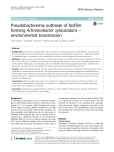-
Články
- Časopisy
- Kurzy
- Témy
- Kongresy
- Videa
- Podcasty
Pseudobacteremia outbreak of biofilm-forming Achromobacter xylosoxidans – environmental transmission
Background:
Achromobacter xylosoxidans (AX) is known for intrinsic resistance to disinfectants. Our laboratory routine surveillance system detected an unexpected rise in AX bloodstream infections in a 2200-bed hospital. An epidemiological investigation was conducted to find the source and disrupt further transmission.Methods:
Outbreak cases were defined as patients with at least one positive blood culture positive for AX from May 2014 to May 2015. Medical records were reviewed, affected wards, as well as the microbiology laboratory were audited. Additionally, microbiologic culture and biofilm staining for suspected antiseptic reusable tissue dispensers were performed, and isolated AX strains were typed using RAPD PCR and PFGE.Results:
During the outbreak period, AX were isolated from blood cultures from 26 patients. The retrospective cohort study did not reveal common risk factors. The clinical features of the case patients suggested a pseudobacteremia. The reusable tissue dispensers containing Incidin® Plus solution product were found to be contaminated with biofilm-forming AX. Typing of the isolates revealed that blood culture isolates were identical with the strains found in the dispensers.Conclusions:
After changing the usage of the product to single-use and educating staff, the outbreak was terminated. Contamination of dispensers occurred due to insufficient reprocessing, since biofilm disrupting steps were not included in the process.Keywords:
Healthcare-associated infections, Infection control, Biofilm, Environmental cleaning, Disinfection, Tissue dispensers, Achromobacter xylosoxidans
Autoři: Frank Günther 1; Uta Merle 2; Uwe Frank 1; Matthias M. Gaida 3; Nico T. Mutters 1*
Působiště autorů: Department of Infectious Diseases, Heidelberg University Hospital, Im Neuenheimer Feld 3 4, D-691 0 Heidelberg, Germany. 1; Department of Internal Medicine, Gastroenterology and Infectious Diseases, Heidelberg University Hospital, Heidelberg, Germany. 2; Institute of Pathology, Heidelberg University Hospital, Heidelberg, Germany. 3
Vyšlo v časopise: BMC Infectious diseases 2016, 16:584
Kategorie: Research article
prolekare.web.journal.doi_sk: https://doi.org/10.1186/s12879-016-1909-0© 2016 The Author(s).
Open access
This article is distributed under the terms of the Creative Commons Attribution 4.0 International License (http://creativecommons.org/licenses/by/4.0/), which permits unrestricted use, distribution, and reproduction in any medium, provided you give appropriate credit to the original author(s) and the source, provide a link to the Creative Commons license, and indicate if changes were made. The Creative Commons Public Domain Dedication waiver (http://creativecommons.org/publicdomain/zero/1.0/) applies to the data made available in this article, unless otherwise stated.
The electronic version of this article is the complete one and can be found online at: http://bmcinfectdis.biomedcentral.com/articles/10.1186/s12879-016-1909-0Souhrn
Background:
Achromobacter xylosoxidans (AX) is known for intrinsic resistance to disinfectants. Our laboratory routine surveillance system detected an unexpected rise in AX bloodstream infections in a 2200-bed hospital. An epidemiological investigation was conducted to find the source and disrupt further transmission.Methods:
Outbreak cases were defined as patients with at least one positive blood culture positive for AX from May 2014 to May 2015. Medical records were reviewed, affected wards, as well as the microbiology laboratory were audited. Additionally, microbiologic culture and biofilm staining for suspected antiseptic reusable tissue dispensers were performed, and isolated AX strains were typed using RAPD PCR and PFGE.Results:
During the outbreak period, AX were isolated from blood cultures from 26 patients. The retrospective cohort study did not reveal common risk factors. The clinical features of the case patients suggested a pseudobacteremia. The reusable tissue dispensers containing Incidin® Plus solution product were found to be contaminated with biofilm-forming AX. Typing of the isolates revealed that blood culture isolates were identical with the strains found in the dispensers.Conclusions:
After changing the usage of the product to single-use and educating staff, the outbreak was terminated. Contamination of dispensers occurred due to insufficient reprocessing, since biofilm disrupting steps were not included in the process.Keywords:
Healthcare-associated infections, Infection control, Biofilm, Environmental cleaning, Disinfection, Tissue dispensers, Achromobacter xylosoxidans
Zdroje
1. Parkins MD, Floto RA. Emerging bacterial pathogens and changing concepts of bacterial pathogenesis in cystic fibrosis. J Cyst Fibros. 2015;14(3):293–304.
2. Chang JM, McCanna DJ, Subbaraman LN, Jones LW. Efficacy of antimicrobials against biofilms of Achromobacter and Pseudomonas. Optom Vis Sci. 2015;92(4):506–13.
3. Kampf G, Degenhardt S, Lackner S, Jesse K, Von Baum H, Ostermeyer C. Poorly processed reusable surface disinfection tissue dispensers may be a source of infection. BMC Infect Dis. 2014;14 : 37.
4. Eigner U, Holfelder M, Oberdorfer K, Betz-Wild U, Bertsch D, Fahr AM. Performance of a matrix-assisted laser desorption ionization-time-of-flight mass spectrometry system for the identification of bacterial isolates in the clinical routine laboratory. Clin Lab. 2009;55(7–8):289–96.
5. Krzewinski JW, Nguyen CD, Foster JM, Burns JL. Use of random amplified polymorphic DNA PCR to examine epidemiology of Stenotrophomonas maltophilia and Achromobacter (Alcaligenes) xylosoxidans from patients with cystic fibrosis. J Clin Microbiol. 2001;39(10):3597–602.
6. Tenover FC. The best of times, the worst of times. The global challenge of antimicrobial resistance. Pharm World Sci. 1995;17(5):149–51.
7. Kampf G, Degenhardt S, Lackner S, Ostermeyer C. Effective reprocessing of reusable dispensers for surface disinfection tissues-the devil is in the details. GMS Hyg Infect Control. 2014;9(1):Doc09.
8. Abdouchakour F, Dupont C, Grau D, Aujoulat F, Mournetas P, Marchandin H, Parer S, Gibert P, Valcarcel J, Jumas-Bilak E. Pseudomonas aeruginosa and Achromobacter sp. clonal selection leads to successive waves of contamination of water in dental care units. Appl Environ Microbiol. 2015;81(21):7509–24.
9. Kupfahl C, Walther M, Wendt C, Von Baum H. Identical Achromobacter Strain in Reusable Surface Disinfection Tissue Dispensers and a Clinical Isolate. Infect Control Hosp Epidemiol. 2015;36(11):1362–4.
10. Tena D, Martinez NM, Losa C, Solis S. Skin and soft tissue infection caused by Achromobacter xylosoxidans: report of 14 cases. Scand J Infect Dis. 2014;46(2):130–5.
Štítky
Infekčné lekárstvo
Článok vyšiel v časopiseBMC Infectious diseases
Najčítanejšie tento týždeň
2016 Číslo 584- Očkování proti virové hemoragické horečce Ebola experimentální vakcínou rVSVDG-ZEBOV-GP
- Koronavirus hýbe světem: Víte jak se chránit a jak postupovat v případě podezření?
Najčítanejšie v tomto čísle- Pseudobacteremia outbreak of biofilm-forming Achromobacter xylosoxidans – environmental transmission
Prihlásenie#ADS_BOTTOM_SCRIPTS#Zabudnuté hesloZadajte e-mailovú adresu, s ktorou ste vytvárali účet. Budú Vám na ňu zasielané informácie k nastaveniu nového hesla.
- Časopisy



